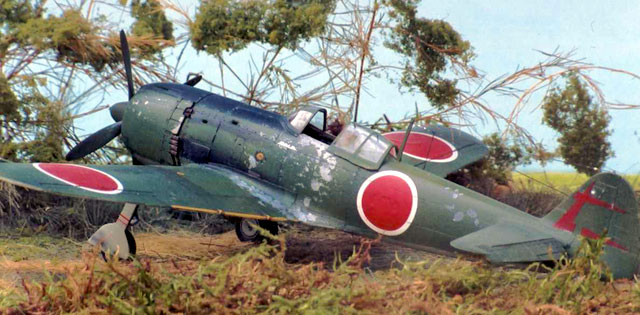|
How good was the Ki-84?
by Andrew Johnson
|
 |
|
Ki-84 Model by Andrew
Johnson |

HyperScale is proudly supported by
Squadron.com
To assist those wishing to assess the qualities of the Ki-84
against its possible allied opponents I have compiled the following
information:
The Aircraft
|
|
Ki-84
|
F4U-1
|
F6F-3
|
P-38J
|
P-51B
|
P-47D-22
|
Spitfire
VIII
|
Design
|
1942
|
1940
|
1941
|
1939
|
1942
|
1941
|
1942
|
Production
|
1944
|
1942
|
1943
|
1943
|
1943
|
1943
|
1943
|
Internal fuel
(imp. gallons)
|
154
|
200
|
188
|
341
|
224
|
253
|
85
|
Range miles
(internal fuel)
|
1125
@ 176 mph
|
1015
|
945
@ 200 mph
|
1175
|
810
@ 253 mph
|
640
|
660
@220 mph
|
Engine model
|
Na
Homare Ha-45
|
P&W
R2800
|
P&W
R2800
|
Allison
V-1710-89
|
Packard
V-1650-3
|
P&W
R2800
|
Merlin
64
|
Engine size (L)
|
35.8
|
46
|
46
|
28+28
|
27
|
46
|
27
|
|
Cylinders
|
18
|
18
|
18
|
12
|
12
|
18
|
12
|
MPG*
|
7.3
|
5.1
|
5.0
|
3.5
|
3.6
|
|
7.8
|
|
Power (hp)
|
1900
|
2250
|
2000
|
2850
|
1620
|
2300
|
1710
|
|
Engine Wt (lb)
|
1826
|
2358
|
2358
|
1422
x2
|
1709
|
2358
|
1645
|
|
Weight
|
5864
|
8694
|
9042
|
12780
|
6840
|
9900
|
5800
|
|
Engine:Airframe
Ratio
|
1:3.2
|
1:3.7
|
1:3.8
|
1:4.5
|
1:4.0
|
1:4.2
|
1:3.5
|
|
Climb rate to 20000 feet
(ft/min)
|
3448
|
1995
|
2360
|
2857
|
2857
|
1818
|
2857
|
|
Wing area (square feet)
|
226
|
314
|
334
|
327
|
233
|
300
|
242
|
|
Max Speed (mph)
|
392
|
425
|
376
|
414
|
440
|
433
|
408
|
|
Wing loading (lb/sq ft)
|
26
|
28
|
27
|
39
|
29.3
|
33
|
24
|
|
Power/weight (hp/lb)
|
0.32
|
0.26
|
0.22
|
0.22
|
0.24
|
0.23
|
0.29
|
The Ki-84 has a lower unladen weight compared to its
Allied opponents with the exception of the Spitfire.

When operating well, the Nakajima ‘Homare’ engine
was reasonably competitive to its Allied opponents. However, its
single stage supercharger proved inadequate when close to the 30,000
feet mark. This would put it at a disadvantage against all of its
allied opponents since the P-38 and P-47 were turbo-supercharged and
F4U, F6F, P-51 and Spitfire VIII had two stage supercharging.

With five separate fuel tanks holding 154 imp.
gallons the Ki-84 had excellent range, an important attribute in the
Pacific theatre. Japanese fighters often had to fly long crossings
over the Pacific ocean to reinforce struggling garrisons. The most
similar aircraft to the Ki-84 in terms of all round performance and
hitting power in this survey is the Spitfire. However, in the range
department the Spitfire is well beaten by the Ki-84, and the RAF as
a whole failed to develop a long range single engined fighter.

From the data tables the Ki-84 could outpace the F6F
but would lag behind the other Allied fighters. However, 390 mph
made the Ki-84 the fastest Japanese fighter of the war. Apparently a
captured example run on high octane petrol, not available to the
Japanese, was able to outpace both the Mustang and Thunderbolt.

This has been determined from unladen weight, but
puts the Ki-84 as the design with the best amount of power for its
weight available. This would mean it could it could theoretically
out accelerate the allied fighters from a low to medium starting
speed.

The favourable power to weight ratio has helped to
give the Ki-84 the best climbing performance in the survey.

The light weight of the Ki-84 coupled with its
fairly generous wing area has given it the best wing loading of all
the fighters present bar the Spitfire. Thus, it could enter a
turning fight with any American fighter with some confidence. The
F6F would have the best turning performance of the American fighters
and would be fairly close to the Ki-84 in the turn.

In this analysis the rounds per minute, projectile
weight and muzzle velocity of all weapons have been multiplied to
give an impact factor with arbitrary units. The Ki-84 with its
combination of two 12.7 mm Ho-103 and two 20 mm Ho-3 guns gives a
creditable performance.

No Japanese fighter aircraft had a better all-round
performance than the Ki-84. As far as protection goes, the Ki-84 had
seat back and head armour of 12 mm steel, and self-sealing fuel
tanks. The self-sealing tanks were not considered as efficient as
those fitted to American aircraft at the time.
The Ki-84 was not clearly superior to any of the Allied fighter
aircraft opposing it. In perfect running order it was perhaps the
equal of any allied fighter at 20,000 feet or below. A good pilot
would be able to take advantage of its excellent turning, climbing
and acceleration characteristics to at least give an allied opponent
a hard fight.
However, good pilots and Ki-84 in excellent running order where in
short supply for Japan between 1944 and 1945.
Review, Tables and Image Copyright © 2002 by
Andrew Johnson
Page Created 30 August, 2002
Last updated
30 August, 2002
Back to HyperScale Main
Page
Back to Reviews
Page
|
Home |
What's New |
Features |
Gallery |
Reviews |
Reference |
Forum |
Search